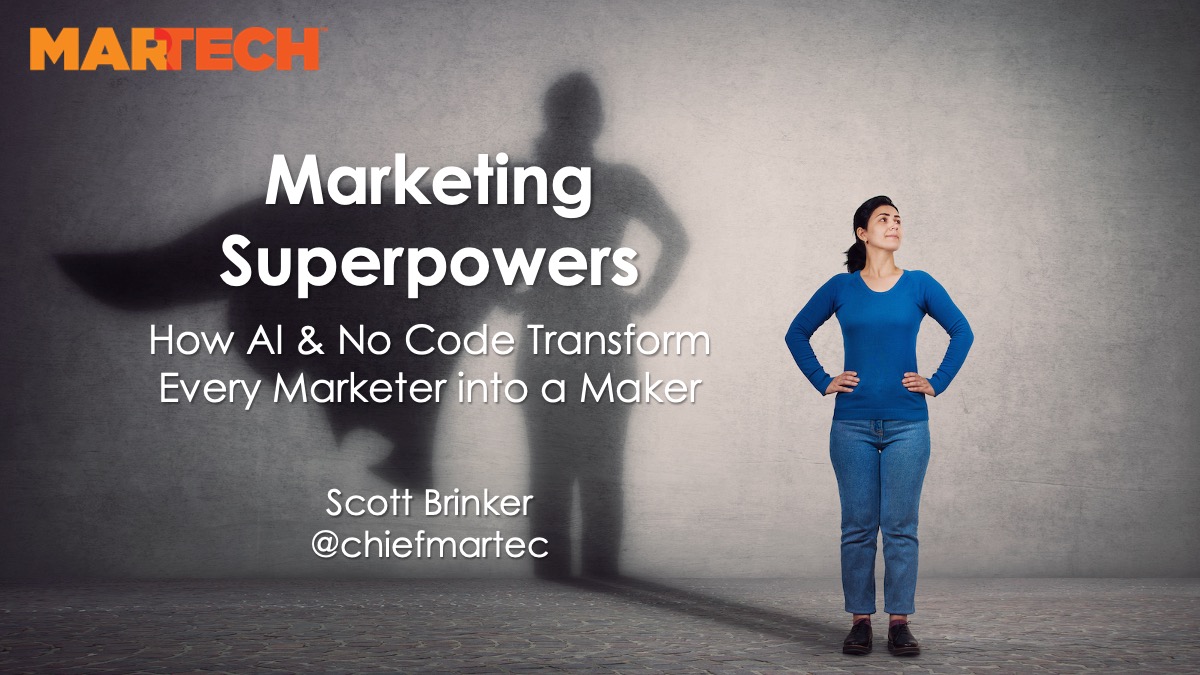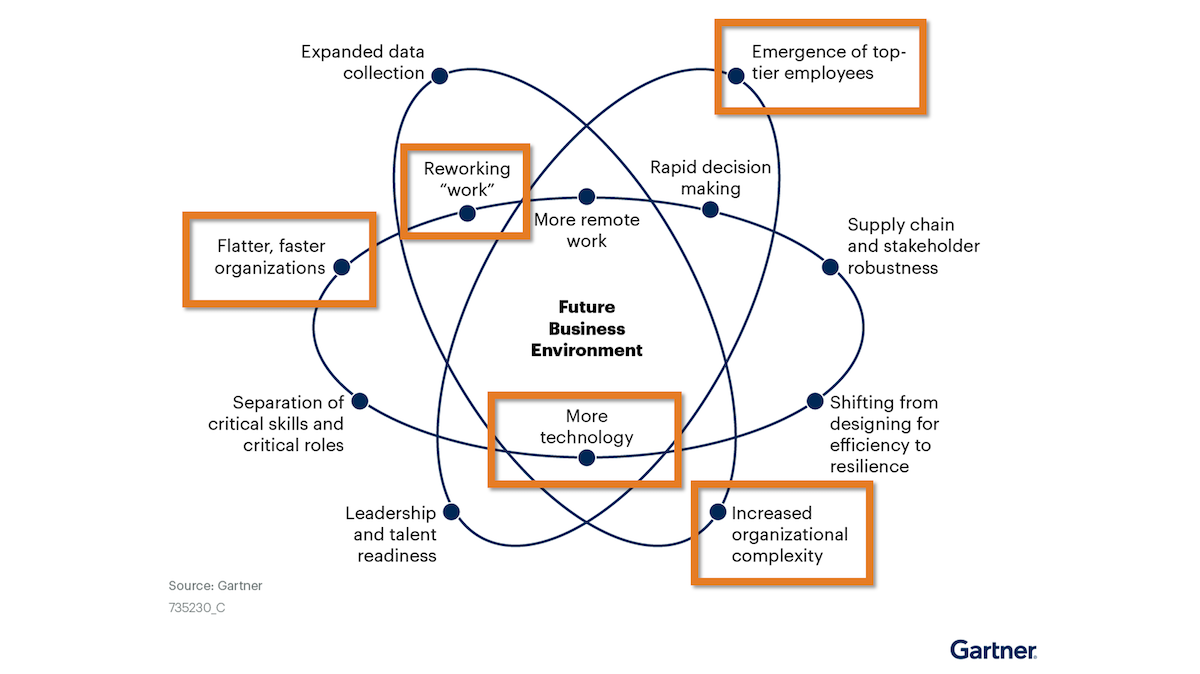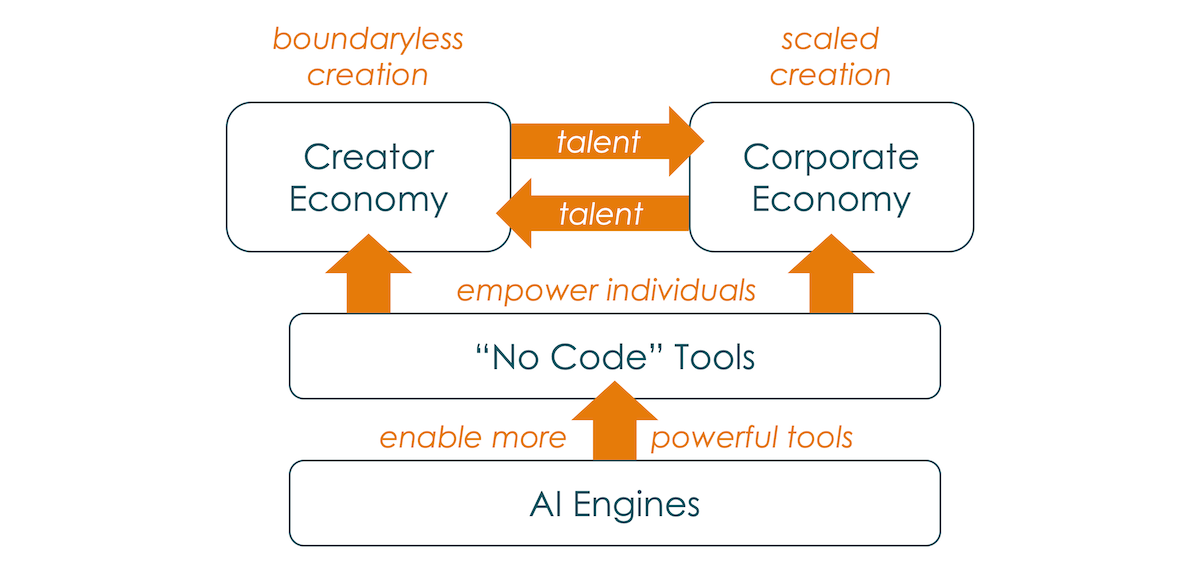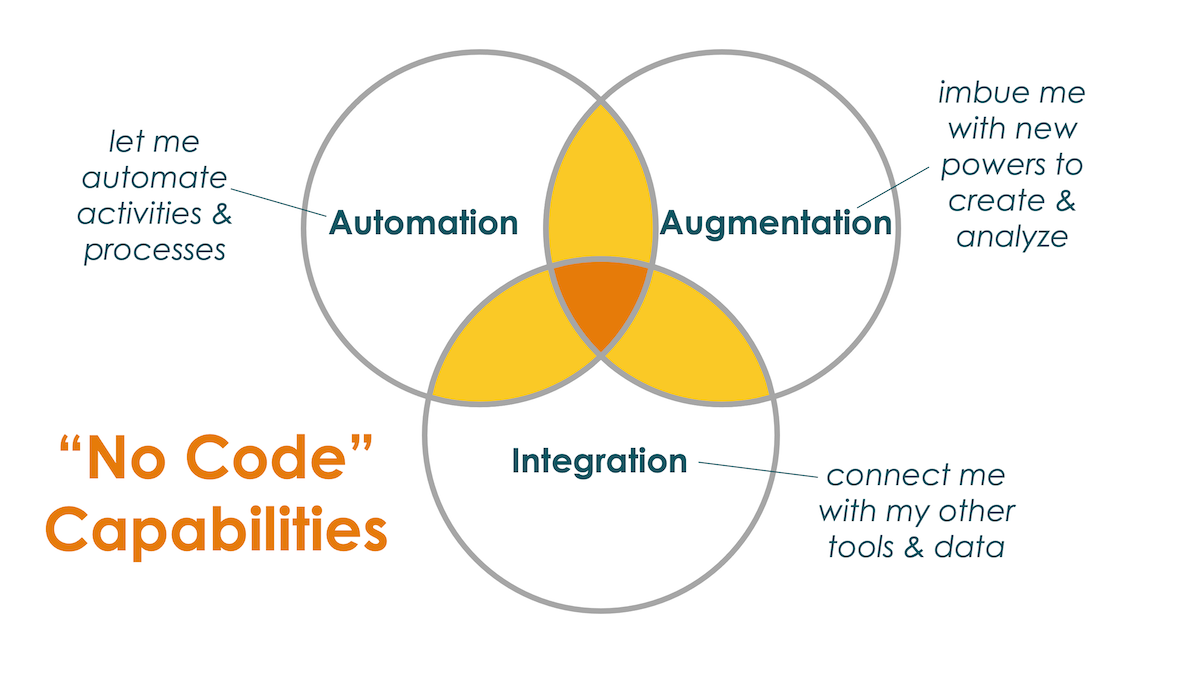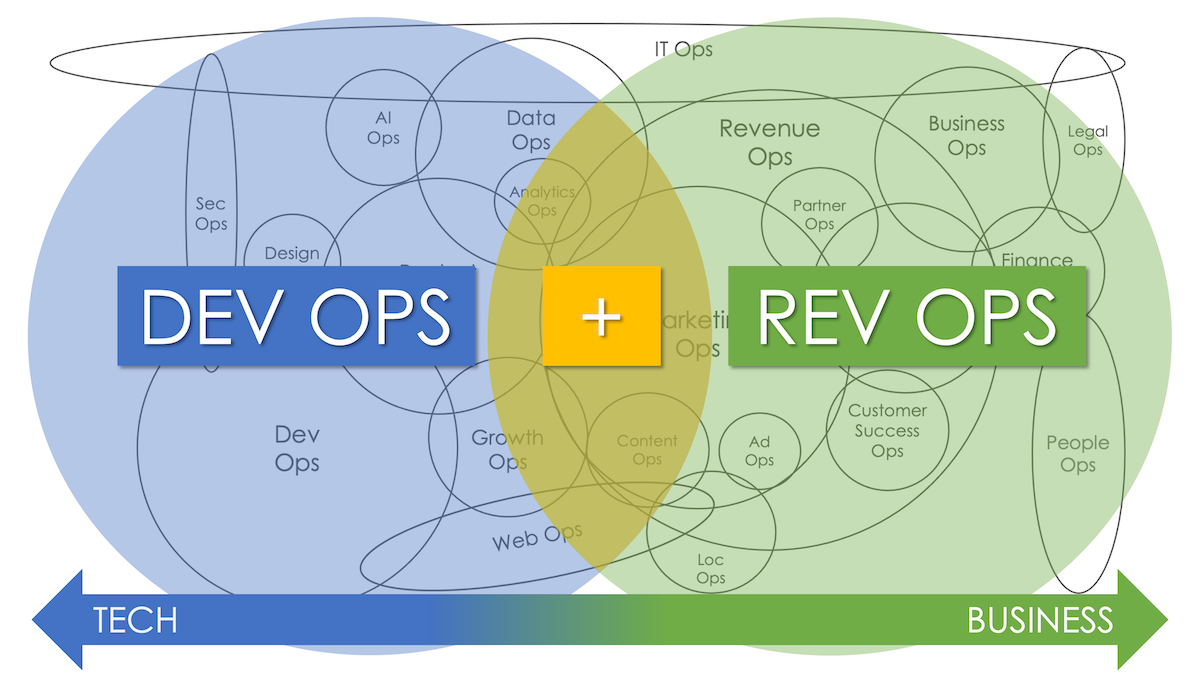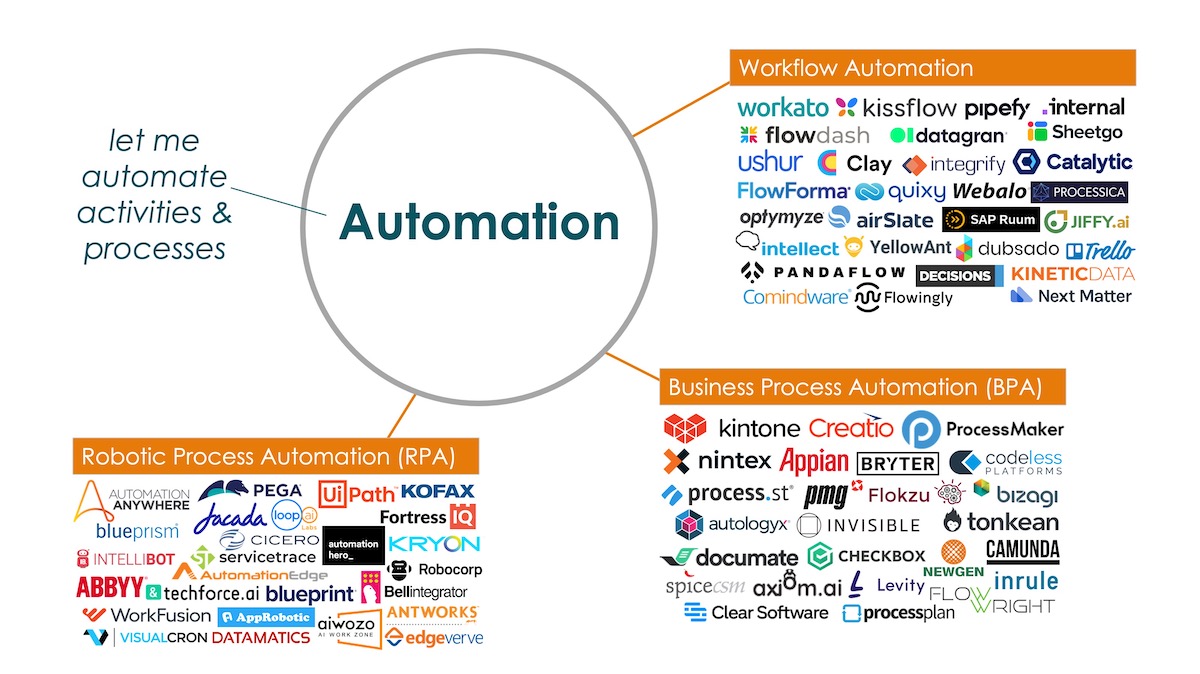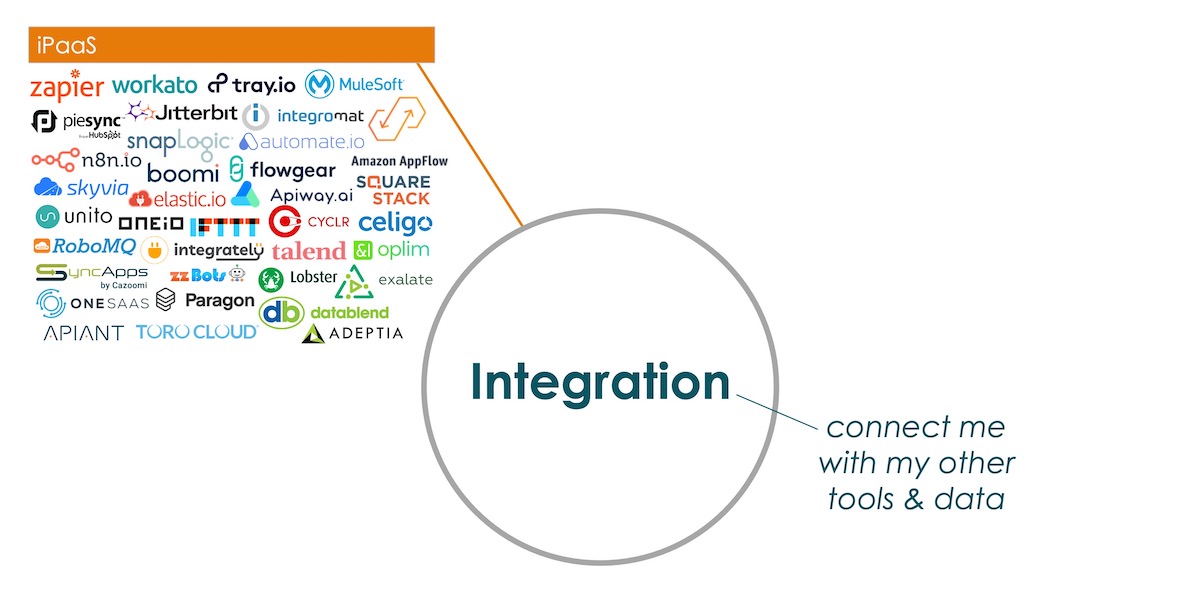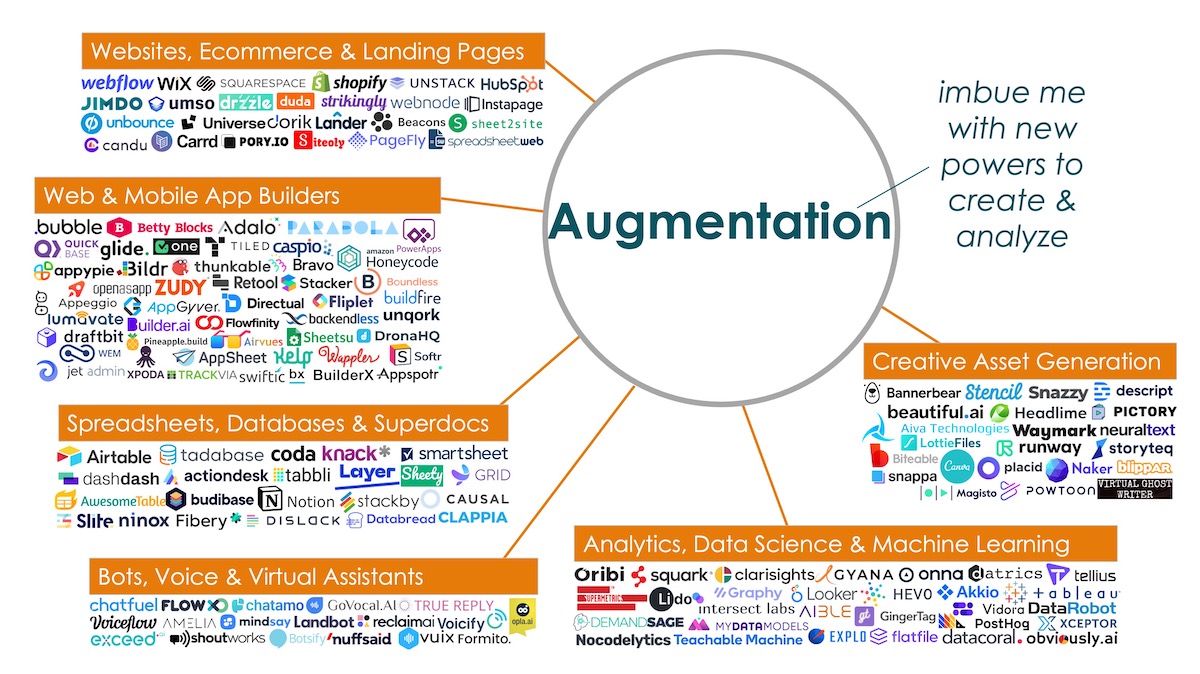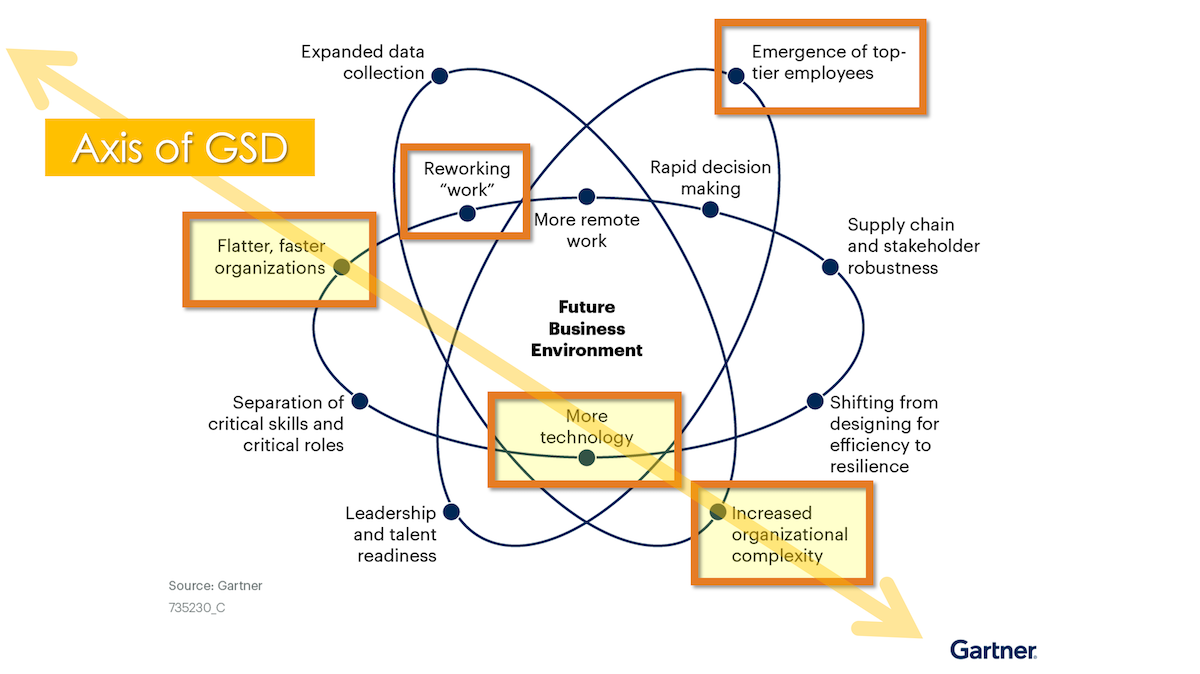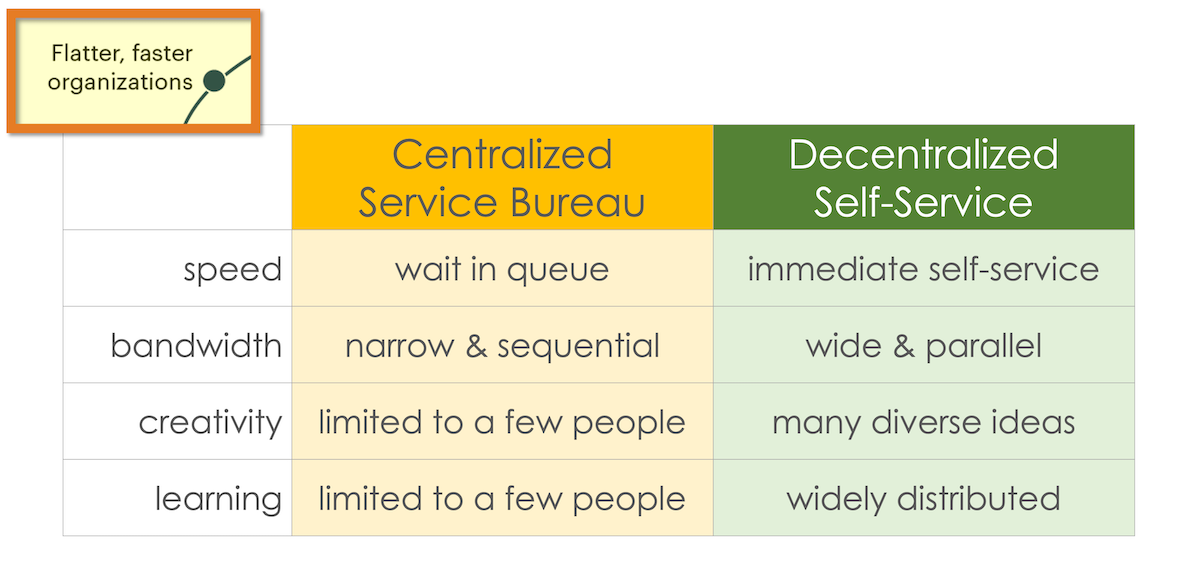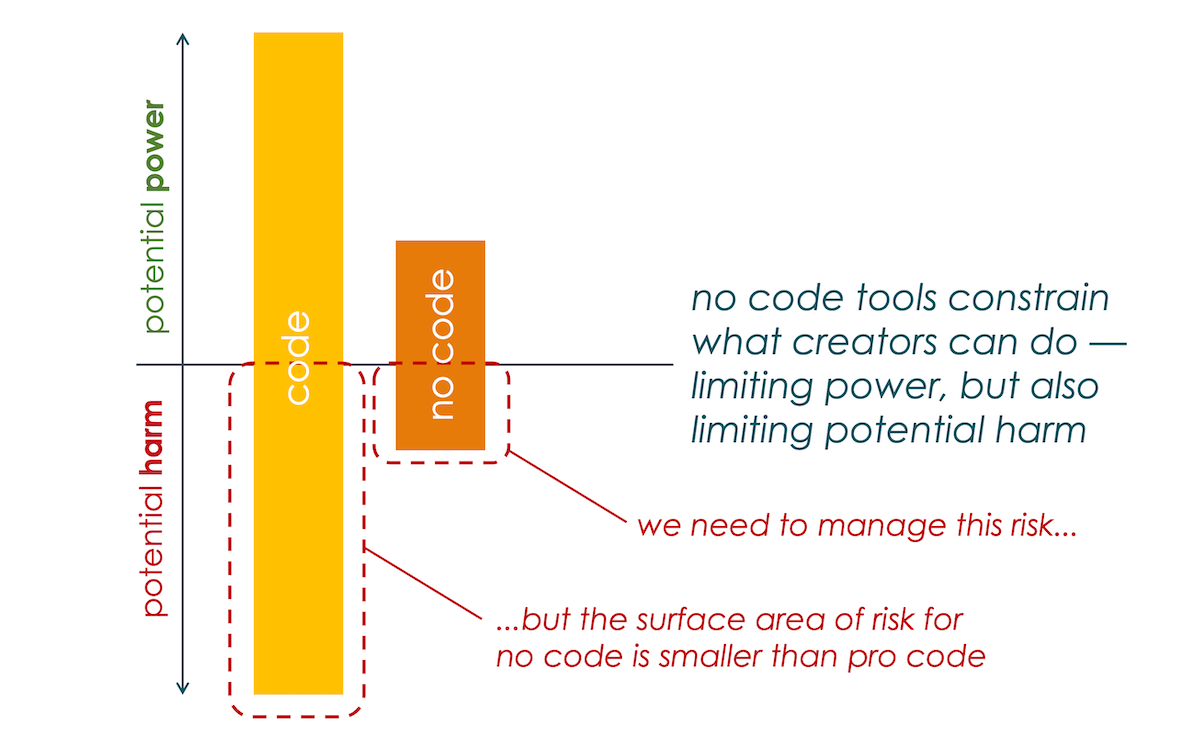Two days ago, I delivered my keynote for the latest (still virtual) MarTech conference, titled Marketing Superpowers: How AI & No Code Transform Every Marketer into a Maker.
I wanted to begin with an original epic-sounding musical theme played by a full orchestra that would get everyone in the superhero mood. But I didn’t spend any time combing through music libraries. Instead, I logged into Aiva.ai, clicked to create a track, chose a musical style (“Fantasy”) — I could have uploaded my own influences instead — and specified tempo, key, and length (less than 30 seconds).
Within less than a minute, Aiva had generated several compositions for me. I picked my favorite, plugged it into PowerPoint, and, boom!, I had my original superhero soundtrack.
This is just one example of the kind of superpowers that marketers now have at their command.
No code and AI are empowering marketers to advance from “What if?” ideas to “What about this?” creations.
“No code” is more than creating without code. It’s more than just building websites or apps that would have previously required knowledge of JavaScript, HTML/CSS, Python, etc.
The broader spirit of the “no code” movement is creating without limits.
The world has changed a lot over the past year. Gartner recently produced a graphic of the different aspects they believe will define business environments here in the post-COVID era. I’ve added orange boxes around five that I want to highlight:
- We’re going to have more technology.
- We’re going to need flatter, faster organizations.
- This will create increased organizational complexity.
- We’re reworking “work” to thrive in this new environment.
- These forces are fostering the emergence of top-tier employees.
This new environment is ideal for “no code” capabilities, as they empowers more people in an organization to leverage more technology in a self-service fashion to move faster.
At the same time, AI and machine learning is advancing rapidly, bringing about a whole new generation of “no code” tools — like Aiva — that dramatically increase the power to create in the hands of individuals.
This major wave of technological empowerment for individuals is enabling the new “Creator Economy.” It is now more viable than ever for people to launch their own business, offering software-leveraged services and creating their own content and apps. (See this terrific post on Unbundling Work from Employment by Li Jin.)
This has triggered the flow of talent from the Corporate Economy to the Creator Economy — in many cases, pushed by the circumstances of the past year.
Yet at the same time, the impressive skills of boundaryless creation that such creators are able to develop and wield are becoming increasingly valuable to — and highly sought after by — corporations. These “maker” individuals can be superstars in flatter, faster organizations. They move fast and build things. Combined with the reach and resources of a larger firm, they can turn boundaryless creation into scaled creation.
These marketing makers/citizen creators are the emergence of top-tier employees.
No Code Capabilities: Automation, Augmentation, Integration
I think of “no code” capabilities in three buckets:
- Automation — let me automate activities & processes
- Augmentation — imbue me with new powers to create & analyze
- Integration — connect me with my other tools & data
Many “no code” products intersect two or three of these capabilities. The major marketing platforms — HubSpot (where I work), Salesforce, Marketo, etc. — incorporate all of them in their core functionality now. But for the sake of a simplified taxonomy, we’ll look at a number of specialist apps that predominantly sit in each of those circles.
But first, it’s worth pointing out that this explosion of digital activity across the organization — a multitude apps, automations, agents, analyses, touchpoints, workflows, etc., all operating in parallel, all contributing and interacting with shared data — is the essence of “Big Ops.”
We’ve seen a myriad of “ops” roles blossom over the past few years. Marketing ops, sales ops, customer success ops, and other business-oriented ops specializations seem to be converging under the banner of RevOps (revenue operations). While dev ops, web ops, product ops, sec ops, data ops, and other technical-oriented ops specializations gravitationally revolve around DevOps, writ large. Big Ops is the union of these converging disciplines.
DevOps = Develop + Deploy
RevOps = Measure + Manage
BigOps = DevOps + RevOps
Big Ops is the thriving digital biosphere of a business in this new decade.
Let’s take a tour of the range of “no code” tools that are booming in that biosphere. As with the martech landscape, the field of no code tools has been experiencing exponential growth over the past couple of years. Not too long ago, there were fewer than 40 companies in that space. Now it’s more than 400 — expansion by an order of magnitude. And growing.
In the Automation sphere, three kinds of products dominate:
- Workflow Automation — processes defined by triggers and actions and well-defined stages — products such as Workato, Kissflow, Pipefy, etc.
- Business Process Automation (BPA) — enabling broader kinds of automation design — products such as Kintone, Nintex, Appian, etc.
- Robotic Process Automation (RPA) — using AI to automate tasks not originally designed to be automated, using techniques such as screen scraping and input emulation — products such as Automation Anywhere, UiPath, BluePrism, etc.
Of course, automation capabilities are often embedded in many other products too. In my keynote, I gave an example of how one of the leaders on my team at HubSpot used our platform’s built-in automation to effortlessly redefine how new partner inquiries would be distributed to partner managers based on their product category. No tickets with IT needed to be filed. All self-serve, drag-and-drop, intuitive if-then logic.
However, the fun stuff with automation begins when you start automating across multiple tools. Integration as a “no code” capability has its own category of products, iPaaS (integration-platform-as-a-service). There are dozens of tools in this category, products such as Zapier, Tray, Snaplogic, etc. Zapier has done a particularly amazing job in this category, and they now have integrations to over 3,000 (!) apps.
I included Workato here too because they’re a terrific example of a no code solution that straddles both Automation and Integration.
There have also been quite a few acquisitions in this space over the past several years: PieSync (acquired by HubSpot), MuleSoft (acquired by Salesforce), Cloudpipes (acquired by Quick Base), Blendr.io (acquired by Qlik), Azuqua (acquired by Okta), Integromat (acquired by Celonis), etc.
These acquisitions make a lot of sense. We live in a heterogeneous app stack world. Integration has become a core competency for every product — especially platforms. And, as we see with the blending of data exchange and workflow sequencing, there’s a lot of headroom for better and deeper integrations to differentiate themselves.
But by far, the most fascinating collection of “no code” capabilities are those that we can label as Augmentation — giving us new powers to create and analyze.
I can barely begin to scratch the surface of the tools that now let marketers and general business users create apps, assets, and analyses that previously would have required an “expert” to do on their behalf:
- Websites, Ecommerce & Landing Pages — build small (or large!) web experiences without knowing HTML, CSS, or Javascript — products such as Webflow, HubSpot, Shopify, Wix, Unbounce, etc.
- Web & Mobile App Builders — create fully functional web apps or even native mobile apps without knowing any programming language, purely visual creation — products such as Bubble, Glide, Adalo, Parabola, etc.
- Spreadsheets, Databases & Superdocs — if you can use a spreadsheet, you can create amazing database apps and project experiences — products such as Airtable, Notion, Rows (formerly DashDash), Smartsheet, etc.
- Bots, Voice & Virtual Assistants — from website chatbots to Alexa skills, you can create conversational experiences for customers without code — products such as FlowXO, Chatfuel, Voiceflow, Exceed.ai, etc.
- Analytics, Data Science & Machine Learning — from simple dashboards to rather sophisticated predictive analytics, data insights are yours to reveal — products such as Oribi, Gyana, Onna, Lido, Obviously.ai, etc.
- Creative Asset Generation — you can be creative without being a pro “creative” (i.e., a professional designer, video engineer, copywriter) — products such as Canva, Descript, Snazzy, Beautiful.ai, Bannerbear, etc.
You don’t have to be a “pro” developer or designer to use these tools, but the work that is being produced with them is pro-level for many organizations.
For instance, in my keynote, I shared an example of how Airtable is used to coordinate marketing operations activities at scale at compnies such as Netflix, Hulu, and Disney. It’s impressive to see the scope of these deployments.
Another no code factoid: apparently 5% of all Alexa skills were built with Voiceflow.
No Code Combinations & Advancing AI Engines
Things get even more exciting when you combine multiple no code tools together in a nearly unlimited spectrum of “recipes.” For example, you can use Zapier to pull new leads from Airtable, pass them into Bannerbear to capture an animated GIF of a prospect’s website, route that image back into Airtable, and then dynamically pass it into your marketing automation or email marketing platform.
Workato claims they have more than 500,000 ready-made recipes.
Don’t even want to get into the details of a recipe? Increasingly, there’s a whole category of no code tools that are built as a layer on top of other no code tools. For examples, products such as Softr, Airvues, Pory.io, and Stacker make it super easy to product a website or ecommerce store from an Airtable database.
This is combinatorial innovation unleashed.
But things are getting even more wild from here…
A new generation of generative AI engines are emerging that will blow your mind in what they can do. Last summer, the OpenAI group unveiled GPT-3, an AI language model that uses deep learning to “write” text that is scarily good. You can read about it in this New York Times article.
Already, dozens of amazing products are being released that leverage the GPT-3 engine, from digital assistants such as Otherside.ai that write your emails for you from rough list of bullet points, to tools such as Snazzy.ai and Headlime that supercharge your copywriting.
The potential for GPT-3 to write code — a programming language is just another language — will also push the boundaries of what “no code” (or “code created by software, not humans”) tools can do.
A couple of months ago, OpenAI revealed their next project, DALL-E, which generates images from text descriptions — such as the example of “an illustration of a baby daikon radish in a tutu walking a dog” above. (Insert remark about legalized marijuana here.) Check out the DALL-E blog for a ton of other examples.
Just consider the awesome power of that capability. Instead of hunting through tons of stock photos, you can simply describe what you want, and a DALL-E-powered tool instantly creates it for you.
From “what if?” to “what about this?” in a matter of minutes.
But can “no code” be managed? Yes.
Skeptics flag a number of concerns with no code tools — ironically running the gamut from “will regular business users even want to build their own creations?” to “yikes, how will we manage all these business users building their own creations!?”
I think it helps to step back and understand that “no code” is a real solution to a real problem. That problem, as Gartner identified, is the need for flatter, faster organizations.
Flatter, Faster Organizations = Decentralized Self-Service
To me, (1) flatter, faster organizations, (2) more technology, and (3) increased organizational complexity is the Axis of GSD (Get, um, Stuff Done). We empower more people to use more technology, and then we manage complexity instead of trying to artificially suppress it. Rigid, hierarchical companies that tightly constrain the adoption of new technologies may achieve theoretical simplicity. But if they’re driven out of business by more savvy and agile competitors, it’s the sound a tree makes when it falls in the forest and there’s no one around to hear it.
Nothingness is the ultimate state of simplicity.
While there is definitely need for centralized controls and expert service bureau models — in-house or outsourced — we can unlock a ton of benefits by enabling decentralized self-service.
Self-service is faster. There’s no waiting around in a queue. It opens up greater bandwidth. A service bureau can be a bottleneck, while self-service harnesses the time and talent of, well, everyone. This also taps greater creativity, as many diverse ideas from across the organization can be realized. Service bureaus are masters at best practices (“center of excellence”). But innovation often sparks from those outside that machinery who bring a fresh perspective (a “beginner’s mind“). And since we learn by doing, self-service capabilities help your broader workforce stay current with the ever-evolving skills needed in a digital world.
“But can’t all these no code users wreak havoc, compared to our highly-trained, disciplined expert programmers?”
There are a few things to keep in mind:
- Self-service capabilities definitely need to be governed by experts. We’ll talk about the 8 P’s of Self-Service “No Code” Martech below as a framework for this.
- Because no code tools constrain what creators can do, they also limit potential harm. I’m not saying there’s no risk of harm, but the geometric expanse by which harm can happen is much, much smaller with no code than open-ended code.
- Not everyone who codes is great at it. (I say this as a former mediocre C programmer myself.) Because code can be so open-ended in what it enables, it can also be nearly unlimited in its potential harm as much as its potential power. Using no code for more creations, with its inherent constraints, is far safer than poorly-coded equivalents.
Instead of comparing the best code programmers against the worst no code users, consider the inverse: the outcomes of the best no code users vs. the worst code programmers. Keep in mind, it’s not Lake Wobegon: at least half of all code-wielding software developers out there are below average.
But arguments of which is better — code or no code — really need to be framed in the context of what is being built.
There’s plenty of advanced software work that nearly everyone agrees shouldn’t be tackled by amateur no code users. Professional software developers will continue to be in demand for a very long time.
At the same time though, there’s a huge number of opportunities that we would like to use software to automate, augment, and integrate what we’re doing that don’t rise to the level of being worth allocating expensive and backlogged pro developer resources to build.
A number of these scenarios can be ideal for no code, self-service solutions — if the idea or project fits one or more of these criteria:
- They’re relatively simple.
- They’re mostly just for internal use (or well-defined external use cases).
- They’re only going to be used by a few users — maybe as few as one.
- They’re relatively short-lived (e.g., a simple campaign for a webinar).
- The nature of the work is very low risk (e.g., not working with sensitive data).
There are certainly many other scenarios where no code solutions can be applied. But the above criteria are a zone that is (a) underserved by pro developers and (b) the risk associated with an amateur no code user building it is small. It’s a lot of upside with very little downside.
That said, there still needs to be governance and leadership for successfully leveraging self-service no code capabilities:
These 8 P’s of Self-Service “No Code” Martech — discussed in more detail in an article that I wrote about platforming marketing a while ago — are how centralized marketing operations and technology managers can put structure and guardrails around decentralized no code empowerment of individauls.
It includes four technology-centric principles:
- Platforms — put in place good no code platforms and services
- Partitions — give individuals/teams their own “space” to work in as much as possible
- Permissioning — set granular permissions for authorized data and services
- Perception — actively monitor for erorrs or unusual behavior and audit usage
But also four people/culture principles:
- Permission — sincerely encourage people to experiment with these tools
- Preparation — provide training and enablement resources to help people use them well
- Principles — establish a few clear guidelines for “good use” of these tools
- Passion — be genuinely passionate decentralized self-service empowerment
With good governance and a focus on the right scenarios where no code brings the greatest net-new value, you can give marketers throughout your organization incredible superpowers. Those who learn to wield them well will be the “top-tier employees” of this new business environment.
The shift from “what if?” ideas to “what about this?” built examples is epic.
